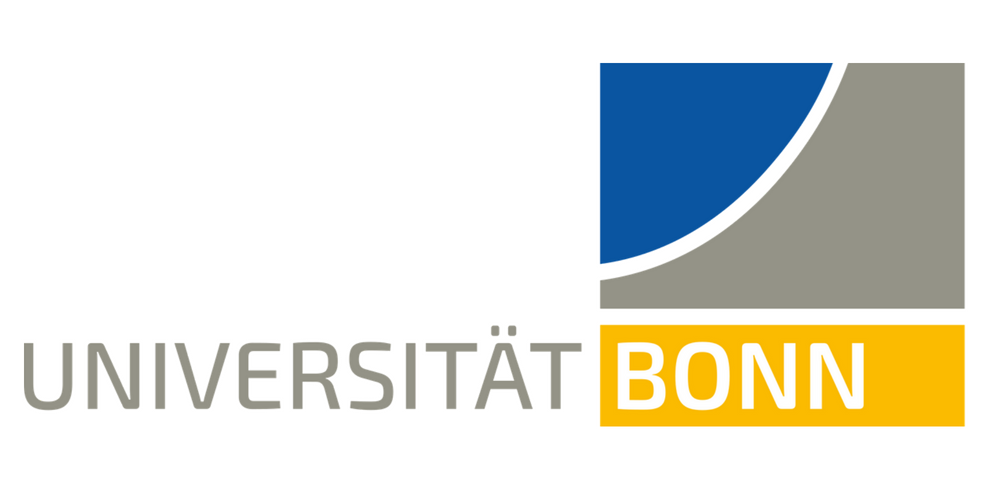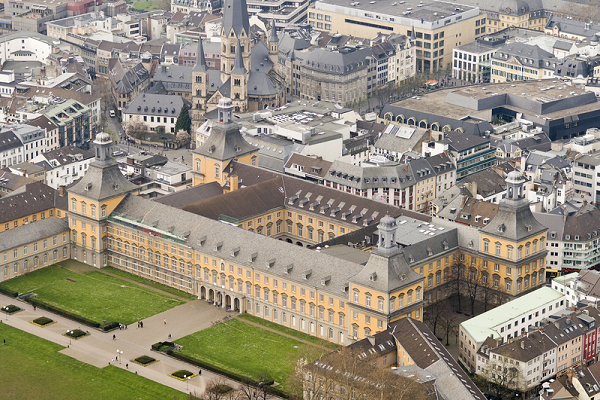From The University of Bonn [Rheinische Friedrich-Wilhelms-Universität Bonn] (DE)
Via
6.12.24
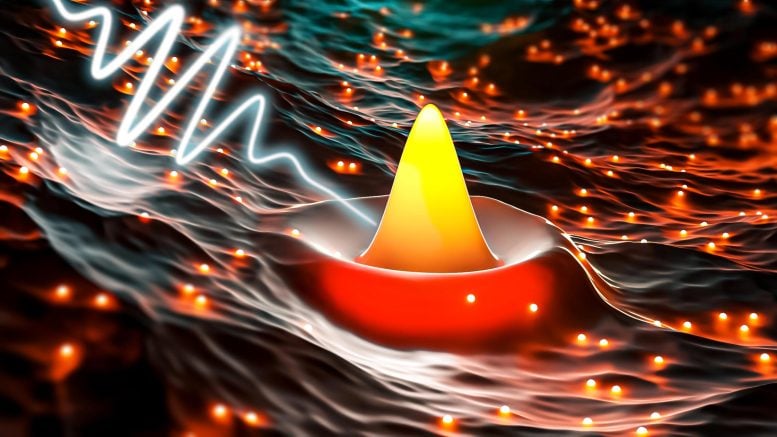
Artist’s view of a photonic Bose-Einstein condensate (yellow) in a bath of dye molecules (red) that has been perturbated by an external light source (white flash). Credit: A. Erglis/Albert-Ludwigs University of Freiburg
Researchers at the University of Bonn have demonstrated that super photons, or photon Bose-Einstein condensates, conform to fundamental physics theorems, enabling insights into properties that are often difficult to observe.
Under suitable conditions, thousands of particles of light can merge into a type of “super photon.” Physicists call such a state a “photon Bose-Einstein condensate”. Researchers at the University of Bonn have now shown that this exotic quantum state obeys a fundamental theorem of physics. This finding now allows one to measure properties of photon Bose-Einstein condensates which are usually difficult to access. The study was published on June 3 in the journal Nature Communications.
Fig. 1: Experimental scheme to probe the regression theorem.
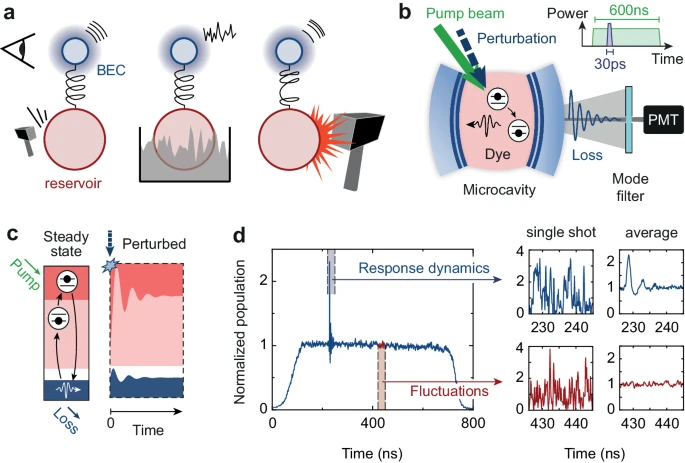
a Mechanical analogue of a photon Bose-Einstein condensate (top, blue) coupled to a molecule reservoir (bottom, red), forming a quantum dissipative oscillator. A weak sudden perturbation of the reservoir (left) leads to a linear response of the average single-time photon number 〈n(t)〉. Immersion into a “coloured-noise” bath (middle) leads to number fluctuations δn, or two-time correlations 〈δn(t)δn(0)〉, for which the regression theorem predicts the same dynamics. For a strong perturbation (right), the response becomes nonlinear. b Dye-filled optical microcavity with photon Bose-Einstein condensate, which is perturbed by a laser pulse irradiated on the dye reservoir (inset). The fluctuation and response dynamics are recorded on a photomultiplier (PMT). c In a steady state, when cavity losses are compensated by pumping the dye, photons (blue) and molecules in the ground and excited state (red) are in equilibrium due to absorption and emission events. After a sudden perturbation of the excited molecules, also the condensate population is perturbed and both systems relax back to their stationary values. d Left: Temporal evolution of the condensate averaged over several time traces. Right: Zoom in on the time window used to analyse the photon number response dynamics (top row), and the time window used for the fluctuation analysis (bottom). The left panels show single-shot data and the right panels the averaged data.
See the science paper for further instructive material with images.
If many atoms are cooled to a very low temperature confined in a small volume, they can become indistinguishable and behave like a single “super particle.” Physicists also call this a Bose-Einstein condensate or quantum gas. Photons condense based on a similar principle and can be cooled using dye molecules. These molecules act like small refrigerators and swallow the “hot” light particles before spitting them out again at the right temperature.
Experimenting With Super Photons in Quantum Gases
“In our experiments we filled a tiny container with a dye solution,” explains Dr. Julian Schmitt from the Institute of Applied Physics at the University of Bonn. “The walls of the container were highly reflective.” The researchers then excited the dye molecules with a laser. This produced photons that bounced back and forth between the reflective surfaces. As the particles of light repeatedly collided with dye molecules, they cooled down and finally condensed into a quantum gas.
This process still continues afterward, however, and the particles of the super photon repeatedly collide with the dye molecules, being swallowed up before being spat out again. Therefore, the quantum gas sometimes contains more and sometimes less photons, making it flicker like a candle. “We used this flickering to investigate whether an important theorem of physics is valid in a quantum gas system,” says Schmitt.
Understanding the Regression Theorem in Quantum Gases
This so-called “regression theorem” can be illustrated by a simple analogy: Let us assume that the super photon is a campfire that sometimes randomly flares up very strongly. After the fire blazes particularly brightly, the flames slowly die down and the fire returns to its original state. Interestingly, one can also cause the fire to flare up intentionally by blowing air into the embers. In simple terms, the regression theorem predicts that the fire will then continue to burn down in the same way as if the flare up had occurred at random. This means that it responds to the perturbation in exactly the same way as it fluctuates on its own without any perturbation.
Blowing Air Into a Photon Fire
“We wanted to find out whether this behavior also applies to quantum gases,” explains Schmitt, who is also a member of the transdisciplinary research area (TRA) “Building Blocks of Matter” and the “Matter and Light for Quantum Computing” Cluster of Excellence at the University of Bonn. For this purpose, the researchers first measured the flickering of the super photons to quantify the statistical fluctuations. They then – figuratively speaking – blew air into the fire by briefly firing another laser at the super photon. This perturbation caused it to briefly flare up before it slowly returned to its initial state.
Demonstrating Nonlinear Behavior in Quantum Systems
“We were able to observe that the response to this gentle perturbation follows precisely the same dynamics as the random fluctuations without a perturbation,” says the physicist. “In this way we were able to demonstrate for the first time that this theorem also applies to exotic forms of matter as quantum gases.” Interestingly, this is also the case for strong perturbations. Systems usually respond differently to stronger perturbations than they do to weaker ones – an extreme example is a layer of ice that will suddenly break when the load placed on it becomes too heavy. “This is called nonlinear behavior,” says Schmitt. “However, the theorem remains valid in these cases, as we have now been able to demonstrate together with our colleagues from the University of Antwerp.”
Implications for Research in Photonic Quantum Gases
The findings are of huge relevance for fundamental research with photonic quantum gases because one often does not know precisely how they will flicker in their brightness. It is much easier to determine how the super photon responds to a controlled perturbation. “This allows us to learn about unknown properties under very controlled conditions,” explains Schmitt. “It will enable us, for example, to find out how novel photonic materials consisting of many super photons behave at their core.”
See the full article here.
Comments are invited and will be appreciated, especially if the reader finds any errors which I can correct.
five-ways-keep-your-child-safe-school-shootings
Please help promote STEM in your local schools.
The University of Bonn [Rheinische Friedrich-Wilhelms-Universität Bonn] (DE) is a public research university located in Bonn, North Rhine-Westphalia, Germany. It was founded in its present form as the Rhein-Universität (English: Rhine University) on 18 October 1818 by Frederick William III, as the linear successor of the Kurkölnische Akademie Bonn (English: Academy of the Prince-elector of Cologne) which was founded in 1777. The University of Bonn offers many undergraduate and graduate programs in a range of subjects and has over 500 professors. Its library holds more than five million volumes.
Among its notable alumni, faculty and researchers are Nobel Laureates, Fields Medalists, Gottfried Wilhelm Leibniz Prize winners as well as some of the most gifted minds in Natural science, e.g. August Kekulé, Heinrich Hertz and Justus von Liebig; Major philosophers, such as Friedrich Nietzsche, Karl Marx and Jürgen Habermas; Famous German poets and writers, for example Heinrich Heine, Paul Heyse and Thomas Mann; Painters, like Max Ernst; Political theorists, for instance Carl Schmitt and Otto Kirchheimer; Statesmen, viz. Konrad Adenauer and Robert Schuman; famous economists, like Walter Eucken, Ferdinand Tönnies and Joseph Schumpeter; and furthermore Prince Albert, Pope Benedict XVI and Wilhelm II.
The University of Bonn has been conferred the title of “University of Excellence” under the German Universities Excellence Initiative.
Research institutes
The Franz Joseph Dölger-Institute studies the late antiquity and in particular the confrontation and interaction of Christians, Jews and Pagans in the late antiquity. The institute edits the Reallexikon für Antike und Christentum, a German language encyclopedia treating the history of early Christians in the late antiquity. The institute is named after the church historian Franz Joseph Dölger who was a professor of theology at the university from 1929 to 1940.
The Research Institute for Discrete Mathematics focuses on discrete mathematics and its applications, in particular combinatorial optimization and the design of computer chips. The institute cooperates with IBM and Deutsche Post. Researchers of the institute optimized the chess computer IBM Deep Blue.
The Bethe Center for Theoretical Physics “is a joint enterprise of theoretical physicists and mathematicians at various institutes of or connected with the University of Bonn. In the spirit of Hans Bethe, it fosters research activities over a wide range of theoretical and mathematical physics.” Activities of the Bethe Center include short and long term visitors program, workshops on dedicated research topics, regular Bethe Seminar Series, lectures and seminars for graduate students.
The German Reference Center for Ethics in the Life Sciences (German: Deutsches Referenzzentrum für Ethik in den Biowissenschaften) was founded in 1999 and is modeled after the National Reference Center for Bioethics Literature at Georgetown University. The center provides access to scientific information to academics and professionals in the fields of life science and is the only of its kind in Germany.
After the German Government’s decision in 1991 to move the capital of Germany from Bonn to Berlin, the city of Bonn received generous compensation from the Federal Government. This led to the foundation of three research institutes in 1995, of which two are affiliated with the university:
The Center for European Integration Studies (German: Zentrum für Europäische Integrationsforschung) studies the legal, economic and social implications of the European integration process. The institute offers several graduate programs and organizes summer schools for students.
The Center for Development Research (German: Zentrum für Entwicklungsforschung) studies global development from an interdisciplinary perspective and offers a doctoral program in international development.
The Center of Advanced European Studies and Research (CAESAR) is an interdisciplinary applied research institute. Research is conducted in the fields of nanotechnology, biotechnology and medical technology. The institute is a private foundation, but collaborates closely with the university.
The Institute for the Study of Labor (German: Forschungsinstitut zur Zukunft der Arbeit) is a private research institute that is funded by Deutsche Post. The institute concentrates on research on labor economics, but is also offering policy advise on labor market issues. The institute also awards the annual IZA Prize in Labor Economics. The department of economics of the University of Bonn and the institute closely cooperate.
The MPG Institute for Mathematics [MPG Institut für Mathematik](DE) is part of the MPG Society for the Advancement of Science [MPG Gesellschaft zur Förderung der Wissenschaften e. V.] (DE), a network of scientific research institutes in Germany. The institute was founded in 1980 by Friedrich Hirzebruch.
The MPG Institute for Radio Astronomy [MPG Institut für Radioastronomie](DE) was founded in 1966 as an institute of the MPG Society for the Advancement of Science [MPG Gesellschaft zur Förderung der Wissenschaften e. V.] (DE). It operates the radio telescope in Effelsberg.
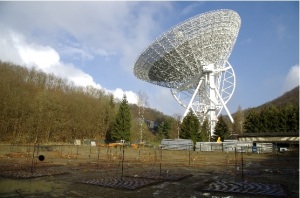
The MPG Institute for Research on Collective Goods [MPG Institut zur Erforschung von Gemeinschaftsgütern)(DE) started as a research group in 1997 and was founded as an institute of the Max-Planck-Gesellschaft in 2003. The institute studies collective goods from a legal and economic perspective.
The Center for Economics and Neuroscience founded in 2009 by Christian Elger, Gottfried Wilhelm Leibniz Prize winner Armin Falk, Martin Reuter and Bernd Weber, provides an international platform for interdisciplinary work in neuroeconomics. It includes the Laboratory for Experimental Economics that can carry out computer-based behavioral experiments with up to 24 participants simultaneously, two magnetic resonance imaging (MRI) scanners for interactive behavioral experiments and functional imaging, as well as a biomolecular laboratory for genotyping different polymorphisms.
Research
University of Bonn researchers made fundamental contributions in the sciences and the humanities. In physics researchers developed the quadrupole ion trap and the Geissler tube, discovered radio waves, were instrumental in describing cathode rays and developed the variable star designation. In chemistry researchers made significant contributions to the understanding of alicyclic compounds and Benzene. In material science researchers have been instrumental in describing the lotus effect. In mathematics University of Bonn faculty made fundamental contributions to modern topology and algebraic geometry. The Hirzebruch–Riemann–Roch theorem, Lipschitz continuity, the Petri net, the Schönhage–Strassen algorithm, Faltings’s theorem and the Toeplitz matrix are all named after University of Bonn mathematicians. University of Bonn economists made fundamental contributions to game theory and experimental economics. Famous thinkers that were faculty at the University of Bonn include the poet August Wilhelm Schlegel, the historian Barthold Georg Niebuhr, the theologians Karl Barth and Joseph Ratzinger and the poet Ernst Moritz Arndt.
The university has nine collaborative research centres and five research units funded by the German Science Foundation and attracts more than 75 million Euros in external research funding annually.
The Excellence Initiative of the German government in 2006 resulted in the foundation of the Hausdorff Center for Mathematics as one of the seventeen national Clusters of Excellence that were part of the initiative and the expansion of the already existing Bonn Graduate School of Economics (BGSE). The Excellence Initiative also resulted in the founding of the Bonn-Cologne Graduate School of Physics and Astronomy (an honors Masters and PhD program, jointly with the University of Cologne). Bethe Center for Theoretical Physics was founded in the November 2008, to foster closer interaction between mathematicians and theoretical physicists at Bonn. The center also arranges for regular visitors and seminars (on topics including String theory, Nuclear physics, Condensed matter etc.).
